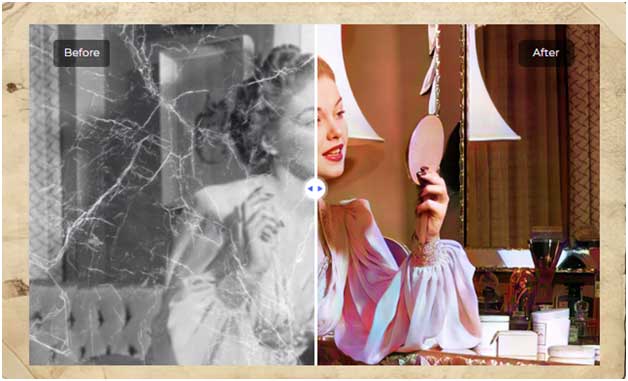Have you ever found an old photo of your grandparents and want to see their faces more clearly? Or your childhood picture faded beyond recognition?
People have tried to fix their old photos for decades. From manual retouching to digital tools, every method had its limits.
In this article, you’ll explore how AI is changing photo restoration. You’ll discover how it works, why it’s powerful and why some people feel uneasy about it.
Old photos fade, blur and lose their detail over time. These photos hold more meaning than just faces. They have personal stories, family ties and emotional value. When such images get lost, the sense of loss feels personal and painful.
These photos hold more meaning than just faces. They have personal stories, family ties and emotional value. A torn wedding photo or a faded portrait of grandparents connects people to their past. When such images get lost, the sense of loss feels personal and painful.
Manual restoration requires patience, steady hands and expert skills. A small mistake is enough to ruin important details. Older software can’t fix deep damage such as heavy blur, faded faces or water stains. It makes the photos editing time-consuming and risky for non-professionals.
AI tools like HitPaw FotorPea simplify this entire process. AI fills the gap left by traditional tools. It gives everyday users the ability to fix their photos without stress or skill. It also means fewer memories lost due to lack of time or knowledge.
AI fills the gap left by traditional tools. It gives everyday users the ability to fix their photos without stress or skill. It also means fewer memories lost due to lack of time or knowledge. This shift has made photo restoration more personal, faster and easier for everyone.
AI photo restoration tools are changing how people repair old pictures. Instead of spending hours fixing faded colors or blurred faces, users can now enhance images with one click. It fixes common problems and restores lost detail in just seconds.
AI photo tools use four main functions. Upscaling boosts resolution. Denoising removes grain. Sharpening fixes blurry parts. Color correction improves tone and contrast. Together, these tools rebuild photos in a balanced and natural way.
| AI Feature | Function | Main Benefit |
|---|---|---|
| Upscaling | Increases image resolution | Makes old photos clearer |
| Denoising | Removes grain and noise | Delivers smooth results |
| Sharpening | Restores missing edges and details | Adds focus and definition |
| Color Correction | Fixes dull or faded colors | Improves skin tones and skies |
 Photo by HitPaw
Photo by HitPaw
HitPaw FotorPea offers different AI modes designed for real user needs. Some of these include Face Enhance, General Denoise, Colorize and Low-Light Repair. Each mode solves a specific problem. Users can choose the one that fits their goal without any technical knowledge.
 Photo by HitPaw
Photo by HitPaw
Face Enhance sharpens blurry portraits. General Denoise smooths grainy backgrounds. Colorize brings life to black-and-white images. Low-Light Repair brightens dark shots. The tool matches each mode to a problem, making it easy for users to restore any kind of photo.
Not all users want the same result. Some care about sharp faces in family portraits. Others want faded holiday pictures to look bright and full of color. Some only need to remove noise for social media sharing.
AI tools like HitPaw FotorPea allow users to match their goal with the right mode. Whether it's better skin tone, clear text or fixing a dark background, each model focuses on what the user needs most.
Some people believe AI photo restoration changes history. They argue that fixing old photos too much can alter their meaning. When AI adds colors or removes flaws, it may rewrite visual records. This can raise questions about what’s real and what’s reconstructed.
“Over-beautification” is another concern. AI tools often smooth out skin, sharpen eyes and brighten clothes. But old photos had grain, cracks and shadows for a reason. These flaws showed the photo’s age and story.
AI can improve visuals, but it must be used carefully. If it changes too much, the photo loses its original charm and emotional depth.
AI can help you to restore old photos, but it also brings new responsibilities. Using AI to bring the past to life should come with care and respect. Restoring an image is more than fixing pixels. It's about preserving truth.
Old photos carry family stories and cultural history. Restoring them with AI can help people feel closer to their roots. A clear photo of a grandparent or a forgotten street can spark memories and start conversations across generations.
Museums and historians also use AI tools to bring clarity to historic archives. But they often keep the original version side by side. That way, viewers see both the beauty and the reality of the past.
People should know when a photo has been enhanced. Adding a simple label like “AI-Enhanced” keeps things honest. It shows respect for the original and avoids confusion.
Marking AI edits helps protect the photo’s meaning. It also prevents fake stories from spreading. A labeled image tells viewers, “This has been changed, but the original still matters.”
In the end, responsible restoration is not about perfection. It’s honoring the past while helping people to see it more clearly.
AI photo restoration can be done with the help of powerful tools. These tools recover lost details and refresh old memories. It reconnects the people with their family history and cultural roots.
With great power also comes the responsibility. Over-editing can erase the line between memory and fiction. Clear labels and ethical use matter. AI can support storytelling, but not replace it.
Discover our other works at the following sites:
© 2025 Danetsoft. Powered by HTMLy